Cueva de las Manos
Cave of the Hands
Useful Information
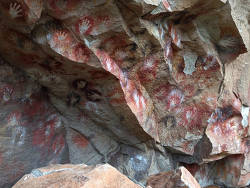
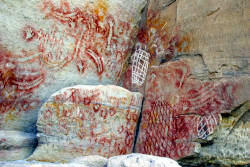
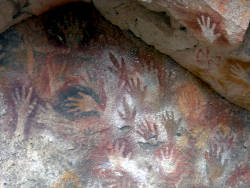
| Location: |
Patagonia Region, Santa Cruz Province.
In the Alto Valle Río Pinturas (High Valley Paintings River), north east of Santa Cruz. (-47.1552731, -70.6559679) |
| Open: |
NOV to APR daily 9-19, tours on the full hour. MAY to OCT daily 10-18, tours at demand. [2019] |
| Fee: |
Adults ARP 400, Argentinian ARP 200, Argentinian Seniors ARP 50, Santa Cruz Residents free, Children (0-11) free. [2019] |
| Classification: |
 Painted Cave Painted Cave
|
| Light: | n/a |
| Dimension: | L=24 m, W=14 m, H=10 m. |
| Guided tours: | D=1 h. |
| Photography: | allowed |
| Accessibility: | no |
| Bibliography: |
María Onetto, María Mercedes Podestá (2011):
Cueva de las Manos: An Outstanding Example of a Rock Art Site in South America
Adoranten. Scandinavian Society for Prehistoric Art: 67–78. ISSN 0349-8808.
ProQuest 1521033595.
pdf
Ian N. M. Wainwright, Kate Helwig, Diana S. Rolandi, Carlos Gradin, María Mercedes Podestá, María Onetto, Carlos A. Aschero (2002): Rock paintings conservation and pigment analysis at Cueva de las Manos and Cerro de los Indios, Santa Cruz (Patagonia), Argentina 13th Triennial Meeting Rio de Janeiro Preprints. Vol. 2. ICOM Preprints. pp. 583 & 585. OCLC 938407252. researchgate |
| Address: |
Dirección de Turismo de Perito Moreno (Perito Moreno Tourism Directorate), Avenida San Martín 2005, Z9040 Perito Moreno, Tel: +54-2963-432732.
E-mail: Instituto Nacional de Antropología y Pensamiento Latinoamericano (INAPL), 3 de Febrero 1370/78 ( C1426BJN), Ciudad Autónoma de Buenos Aires, Tel: +54-11-4782-7251, Tel: +54-4783-6554. |
| As far as we know this information was accurate when it was published (see years in brackets), but may have changed since then. Please check rates and details directly with the companies in question if you need more recent info. |
|
History
| BP 13,000 to 9,500 | paintings made by Tehuelches natives. |
| BP 7350 | 14C date for archaeological remains. |
| 1941 | discovered by Alberto M. de Agostini. |
| 1950 | detailed description with three black and white and one colour foto published in the book Los Andes. |
| 1973 | archaeological excavation by Carlos J. Gradin, Carlos Aschero, and AM Aguerre. |
| 1980 | protective bars in the main sectors to prevent direct public contact with the paintings by Turismo de la Nación. |
| 1995 | The National Institute of Anthropology and Latin American Thought participates in the management and scientific advice. |
| 1999 | inscribed on the UNESCO World Heritage List. |
Description
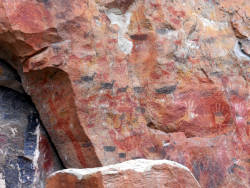
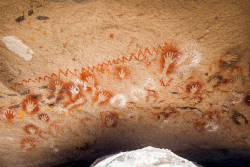
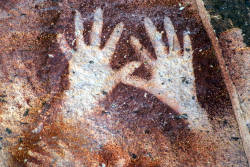

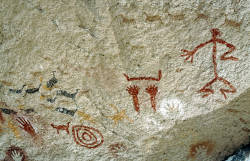

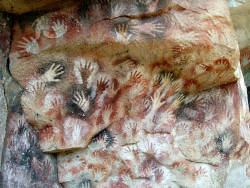


In the Alto Valle Río Pinturas (High Valley Paintings River), north east of Santa Cruz. The caves are located on private lands, visitors are only allowed due to kindness of the owners.
The Cave of the Hands, is named after the stencilled outlines of human hands in the cave, but there are also hunting scenes as well as many pictures of animals, such as the guanacos (Lama guanicoe) or lama, which are still common in the region. More than 890 paintings of human hands appear together with geometric figures and animals along the walls of the cave which is only 24 meters deep by 15 meters wide at the entrance and 10 meters high. The hands painted in live colors varying from red, violet and reddish violet, white, black, yellow, to orange ochre and a few in green. They occur as both negative and positive forms. The great majority are left hands belonging to children, youths and adults.
The Caves of the Hands was a sacred site for the Tehuelches Indians, who lived in the area long before the Europeans arrived. They used the cave during their Summer hunting season, moving back to the coast in the Autumn to avoid the harsh Patagoniaian Winters.
Text by Tony Oldham (2002). With kind permission.
Since Tony wrote this description a lot has happened. Actually it was already outdated in 2002 as it was based on an older publication. The site quickly became famous and well visited during the 1980s, and the owner was simply not prepared to handle this. The installation of protective bars in the main sectors to prevent direct public contact with the paintings was a good start, but insufficient. And it was made by Turismo de la Nación, in a try to convince the owner to keep the site open. But of course, the protection measures often exceed the income from entrance fees, and that is a public task.
During the 1990s the site became a national treasure and a UNESCO WHL site. This requires both, making the site accessible to the public and protecting it from damages. It seems the main player in this game was the Instituto Nacional de Antropología y Pensamiento Latinoamericano (National Institute of Anthropology and Latin American Thought), a governmental organisation. They organized the handling of the visitors, made a management plan, and made basic decisions.
Today the site is gated with a permanent presence of personnel on site. Visits are possible every day but only on guided tours by specialized guides. Walkways, railings and decks along the painting circuit allow access without damaging the paintings. Quite impressive is the fact that it is allowed to take pictures, most painted caves do not allow this. One possible reason is probably that the cave is open to daylight, and it is quite easy to make pictures without flash. There are informative signs, an interpretation center which also works as a visitor center and the new Carlos Gradín Museum with its laboratory. The cave even has a small airfield so you may arrive by plane, in the huge country probably a good idea. The development is quite impressive.
The cave contains, as the name suggests, mostly hands, which were made by pressing a hand to the wall and then blowing paint with the mouth. The paint forms a circular patch while the hand covers the wall and creates a negative without paint. This technique is found all over the world, because it is so simple. There are over 2,000 hand prints on the site. Often forgotten is that there are numerous other paintings, of animals and humans. There are actually three basic categories: people, the animals they ate, and the human hand. They hunted guanacos for survival, so there are numerous paintings of guanacos.
The paintings were made during several millennia, in other words there were not only different artists, there were actually different people who added their paintings to the wall. The motives, the painting technique, and even the used colours changed over time. The artwork decorates the interior of the shelter and the surrounding cliff faces.
More interesting is actually the age of the paintings. Dating paintings is rather difficult, radiocarbon dating of the artwork itself is only possible if the colour contains charcoal. Stratigraphic dating is possible when a piece of the rock wall with art on it falls to the ground. Then it is possible to date the layer and all other content has the same age. Stylistic aspects and superimpositioning (overlap) of the different parts of the art give additional hints. Due to enormous amount of artworks this site has become the best source of knowledge about early hunter-gatherer groups in South America. While ages between 9,000 and 3,000 years BP are quite accepted and were also made in other caves of Argentina, there are some datings around 15,000 years BP, which are highly controversial. They actually collide with the generally accepted Clovis theory, which postulates a colonization of the Americas across the Bering Strait and through Alaska. However, as always in science, the theory is continually adapted to the increasing number of known facts. There are other archaeological sites in South America, southern Chile and Monte Verde, which were dated up to 32,000 BP. This would suggest an earlier colonization of South America probably from Polynesia.
Since the 19th century travelers, adventurers, explorers and scientists visited the Pinturas River. The renowned English traveler George Musters was the first white man in this area in 1881, but he did not find the paintings, or never mentioned them. Neither did Clemente Onelli, famous because he accompanied Perito Francisco P. Moreno on his travels, when he visited the area in 1904. So the actual discoverer, or re-discoverer, was Alberto M. de Agostini who found them in 1941, and wrote a detailed description in his book Los Andes in 1950. He also published three black and white and one colour foto. So the site became known and in the same year the first studies of the place by archaeologists began. Now the site was published in scientific magazines. In 1964 topographer and archaeologist Carlos J. Gradin began to explore the area. But the first serious exploration was started in 1973 by Carlos J. Gradin, Carlos Aschero, and AM Aguerre.
The Cueva de Las Manos is not very deep, but it is a real cave, not just an overhanging cliff face. It’s a single chamber which is 20 m deep, 15 m wide and 10 m high. It is located about 88 m above the upper course of the Pinturas River and was difficult to access. But it was definitely used as a shelter, at least for some time, as excavations revealed stone tools, bones and skins of animals, and even hearths.
 Subterranean World Heritage List
Subterranean World Heritage List Search DuckDuckGo for "Cueva de las Manos"
Search DuckDuckGo for "Cueva de las Manos" Google Earth Placemark
Google Earth Placemark OpenStreetMap
OpenStreetMap Cueva de las Manos - Wikipedia
Cueva de las Manos - Wikipedia Cueva de las Manos, official website
Cueva de las Manos, official website  (visited: 07-NOV-2020)
(visited: 07-NOV-2020) Index
Index Topics
Topics Hierarchical
Hierarchical Countries
Countries Maps
Maps